Read TL;DR
- Customer retention cost (CRC) is a key financial efficiency metric for SaaS companies, as it tracks the amount the company spends to retain its current customers.
- It includes all your expenses on customer success, support, engagement, and loyalty programs over the reporting period.
- High CRC reduces profit margins, while an optimized CRC increases customer lifetime value and supports sustainable growth.
- SaaS teams must enhance usability, customer support, and onboarding to optimize customer retention and build loyalty through personalized engagement strategies.
It’s no secret that for SaaS companies, retaining their existing customers is more profitable than acquiring new ones. But customer success isn't that simple. Customer retention is a big deal for SaaS companies, and most invest heavily in it.
Customer retention cost (CRC) tracks a SaaS company’s expenses on customer satisfaction efforts such as support, engagement, and loyalty programs over a specific period. It is a crucial metric for SaaS companies, as recurring revenue from long-term customers drives growth and profitability.
In this article, you'll learn how customer retention costs affect SaaS profitability, how to calculate them, and simple strategies to optimize for long-term growth.
Table of Contents
What are customer retention costs?
CRC is a financial metric that helps you calculate how much you need to invest to ensure a customer will use your SaaS solution for the long term.
For SaaS companies, customer retention generates a steady stream of revenue. Tracking CRC is a great way to manage budgets, make smarter investments, and measure customer success more effectively.
What’s included in customer retention costs?
Determining what's included under CRC as a customer retention expense can get tricky. To calculate the CRC accurately, you'll want to include all customer retention expenses.
Key components to include in your CRC are:
- Customer-facing teams: Include the salaries and benefits you pay customer success managers, account managers, support reps, and training teams as they resolve customer issues that could lead to churn.
- Retention tools and platforms: The cost of software you use for keeping customers happy, such as customer experience platforms, survey tools, engagement software, onboarding tools, and even churn prediction software.
- Loyalty and retention programs: All expenses made to run and market loyalty programs, referral bonuses, and renewal incentives that help retain customers.
- Customer marketing campaigns: Cost of nurturing existing relationships through email drip campaigns, webinar invitations, upsell nudges, or tailored content.
- Onboarding and training costs: Directly attributable personalized training, onboarding documentation, and tutorials that help your customers use your solution effectively and reduce churn.
- Discounts and renewal incentives: The monetary offer or incentives you provide to retain a customer, such as a discounted renewal rate or an extra month of service.
- Customer feedback efforts: The price of gathering feedback from customers through net promoter score (NPS) surveys, customer satisfaction research, and user interviews. These help you improve your product and customer engagement.
Cost of customer acquisition vs retention
Customer acquisition costs (CAC) for your SaaS company are typically higher than the amount you spend to retain them (CRC). Here's a brief comparison of the cost of customer acquisition vs. retention to highlighting their key differences:
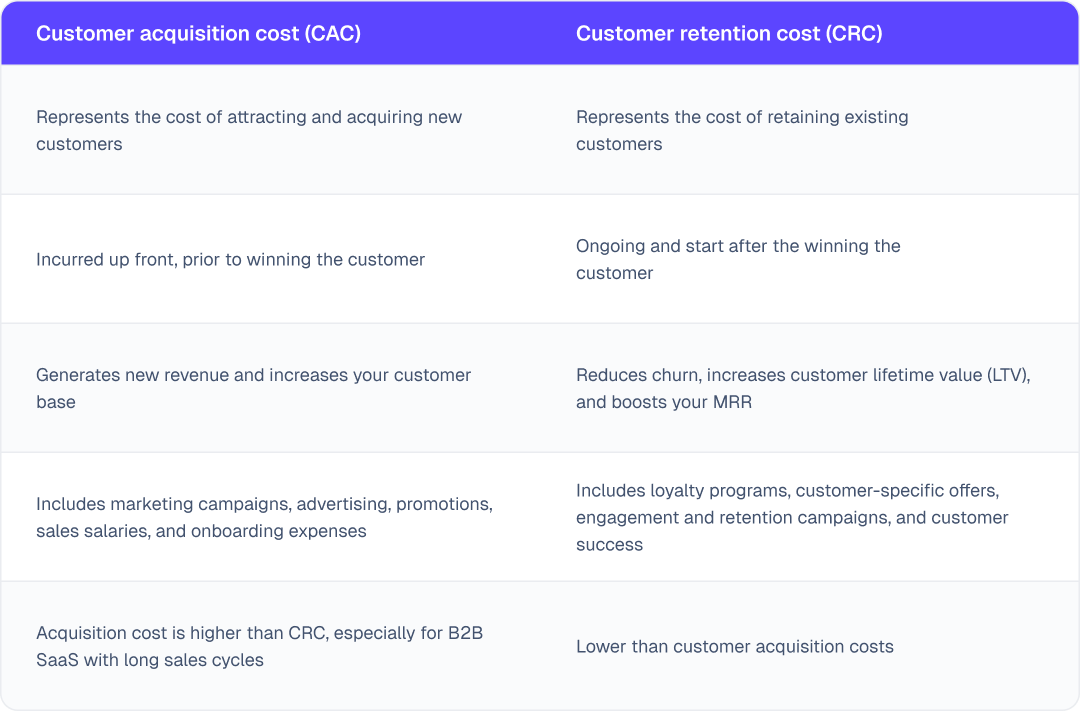
Learn more about SaaS metrics here
How to calculate customer retention cost
As you can see from the formula below, calculating customer retention cost is pretty straightforward:

In this formula:
- Total retention spend simply includes all expenses on salaries and tools used by customer success, support, and marketing teams.
- The number of active customers refers to users actively using or subscribed to your service during the reporting period.
It's important to note that you can get very granular with your CRC calculations, segmenting your customers by cohorts based on different characteristics, such as when they became a customer or by the type/size of plan they have. While complex, this is especially useful if you're implementing the bowtie sales funnel for SaaS, which recognizes customer retention as a critical component of potential growth for SaaS businesses.
We'll keep it simple here with an example of calculating the quarterly CRC for a SaaS company.
Our example company spent the following on customer retention over the last quarter:
- Customer success team salaries - $150,000
- Support software subscriptions - $50,000
- Loyalty discounts - $50,000
The total retention spend for the quarter is $250,000.
During the same quarter, the company had 5,000 active customers.
Here's how we can use this information to calculate the company's CRC using the above formula:

Note that the basic CRC formula assumes it costs the SaaS company the same to retain every customer, but that's not true in a real-world scenario. Your enterprise clients usually need more resources, like dedicated account managers and premium support, while smaller customers tend to rely on help centers and automated tools.
As you see, retention costs differ for each customer segment. Ideally, you should track how much it costs to keep a customer during their entire time with your company for the most accurate CRC calculation.
Here's a formula you can use to calculate lifetime customer retention cost:

This provides a clearer understanding of long-term profitability and enables you to benchmark your CRC against customer lifetime value (LTV). If your lifetime CRC is high but LTV is even higher, it indicates a healthy relationship. If your CRC is close to LTV, that's a red flag.
Here is an example of calculating lifetime customer retention cost (CRC) per customer. Note that in this example, we're calculating the lifetime CRC in quarters. If your company tracks CRC in terms of months, you could use the same equation with both variables expressed in months instead of quarters.
The company in our example has:
- Quarterly CRC of the company is $50 per customer
- Average customer lifetime of around 2 years = 8 quarters
Applying the formula above, we can calculate the company's lifetime CRC per customer:
.png)
Accurately calculating lifetime CRC requires up-to-date data on churn rates and customer retention time. If you want to dig deeper, you can also track cohorts, segment by plan size, or examine retention curves.
Why measure customer retention costs?
Retention costs are scattered across departments and functions, making them easy to miss, and SaaS leaders who track CRC can easily evaluate their retention strategies to ensure their investments align with growth goals.
Here's why measuring CRC is helpful:
- Measure ROI and fine-tune your retention efforts: CRC evaluates the ROI of retention efforts like loyalty programs by comparing them to metrics like CLV or MRR. If, in case, high CRC doesn't reduce churn, it's time to shift to smarter strategies like better onboarding.
- Make smarter choices about pricing and profitability: SaaS finance leaders should deeply assess how retention efforts affect margins. They can then use these insights to build pricing models that cover retention costs to stay profitable. For clients with high CRC, premium pricing helps cover costs while maintaining service quality.
- Calculate the real customer lifetime value: Including CRC in your CLV calculations helps unlock a deeper understanding of customer profitability. You can use the insights to focus on high-value segments and cut costs on low-margin accounts.
- Identify ways to save costs: Analyzing CRC reveals inefficiencies, such as oversized support teams or ineffective tools. For example, CFOs can identify and replace cost-intensive areas, such as manual support for low-tier customers, with self-serve solutions.
How much do SaaS companies spend on customer retention?
Based on its 2025 survey of private B2B SaaS companies, SaaS Capital found that equity backed companies are spending 14% more on customer success than bootstrapped businesses.
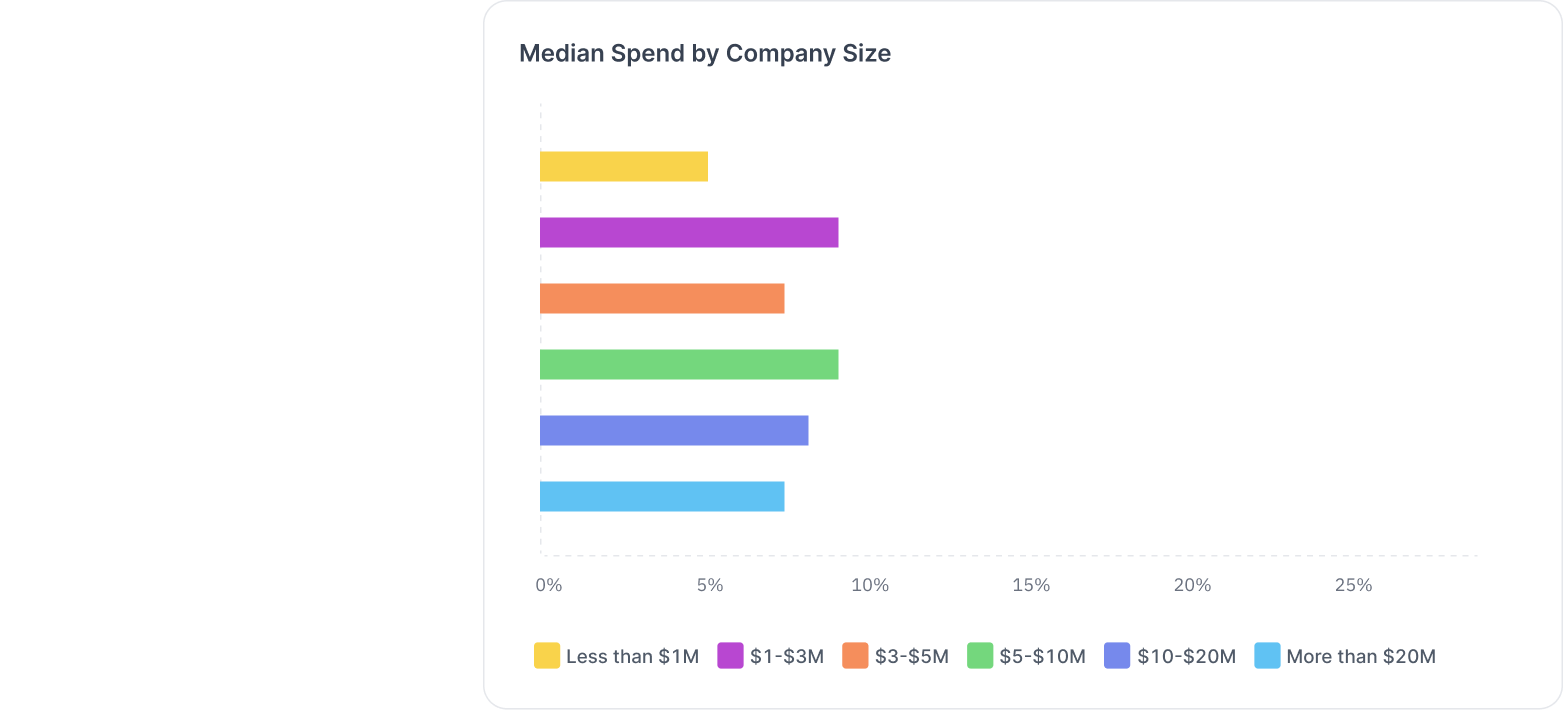
The survey also revealed that higher growth companies in both segments are spending more than their slower-growing counterparts:

The report also provides benchmarks for customer success spending by company size as measured by ARR:
.png)
How to reduce customer retention costs?
Optimizing CRC isn't about just cutting retention budgets. It's about boosting efficiency. Here are some strategies SaaS finance leaders can use to do that:
- Simplify onboarding: Support requests and chances of churn increase if customers find your onboarding process slow or confusing. Provide tutorials, guided setup, and self-paced onboarding options to lighten your support team's workload.
- Implement self-service and automation solutions: Knowledge bases, chatbots, and in-app guidance help customers resolve issues quickly without contacting support. Automating tasks such as billing reminders and check-in emails also reduces manual work.
- Improve your product experience: Use product analytics to identify underused features and tools that are causing users friction. A smoother, more intuitive product experience reduces frustration and increases engagement, which helps lower your CRC over time.
- Focus retention strategies on customer groups: Segmenting your users by behavior, industry, or plan size allows you to tailor retention efforts. High-value customers may require more hands-on support, while others may respond well to automation.
- Use data-driven insights for proactive retention: Use churn prediction models, customer health scores, and feedback analysis to act before a customer disengages. Proactive outreach based on data can prevent churn before it happens and reduce the cost of reactive support.
How Drivetrain helps turn customer retention data into strategy
Tracking CRC across fragmented systems like CRMs, finance software, customer success platforms, and analytics platforms isn't always easy.
Modern FP&A tools like Drivetrain help finance, marketing, customer support, and operations teams consolidate all their financial and customer data into a single platform. With real-time dashboards and automated metric tracking, you can automate CRC calculations and visualize your CRC alongside CAC, LTV, churn rate, and other SaaS metrics.
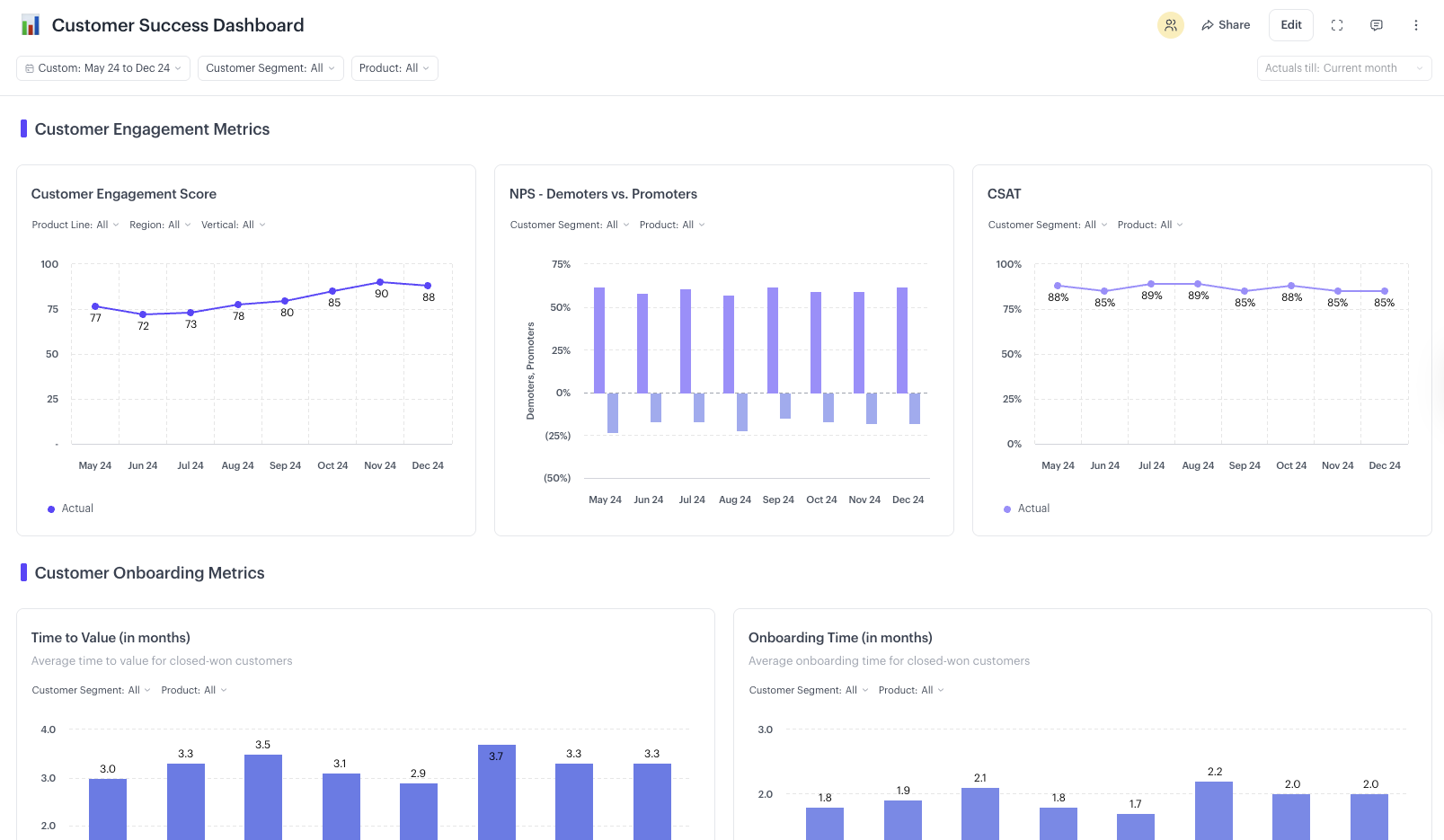
Drivetrain allows you to break down expenses by customer segment, highlight inefficiencies, and track trends over time, making it easier to optimize spending. You can also model different retention strategies, run what-if scenarios, and see how changes in spending affect your bottom line. By connecting your operational and financial data, Drivetrain helps you move beyond guesswork and make smarter spending decisions to retain your hard-earned customers.
FAQs
Customer retention costs for SaaS companies encompass all expenses that support existing customers, including salaries for support teams, costs for tools such as CRMs, expenses on loyalty programs, renewal incentives, marketing campaigns, training, and customer feedback.
Retention in SaaS refers to keeping customers actively engaged and subscribed over time, reducing churn. Renewal specifically refers to customers continuing their subscription at the end of a billing cycle.
To calculate customer retention cost, divide your total retention-related expenses by the number of active customers during a given period. For a longer-term view, multiply the monthly CRC by the average customer lifespan.

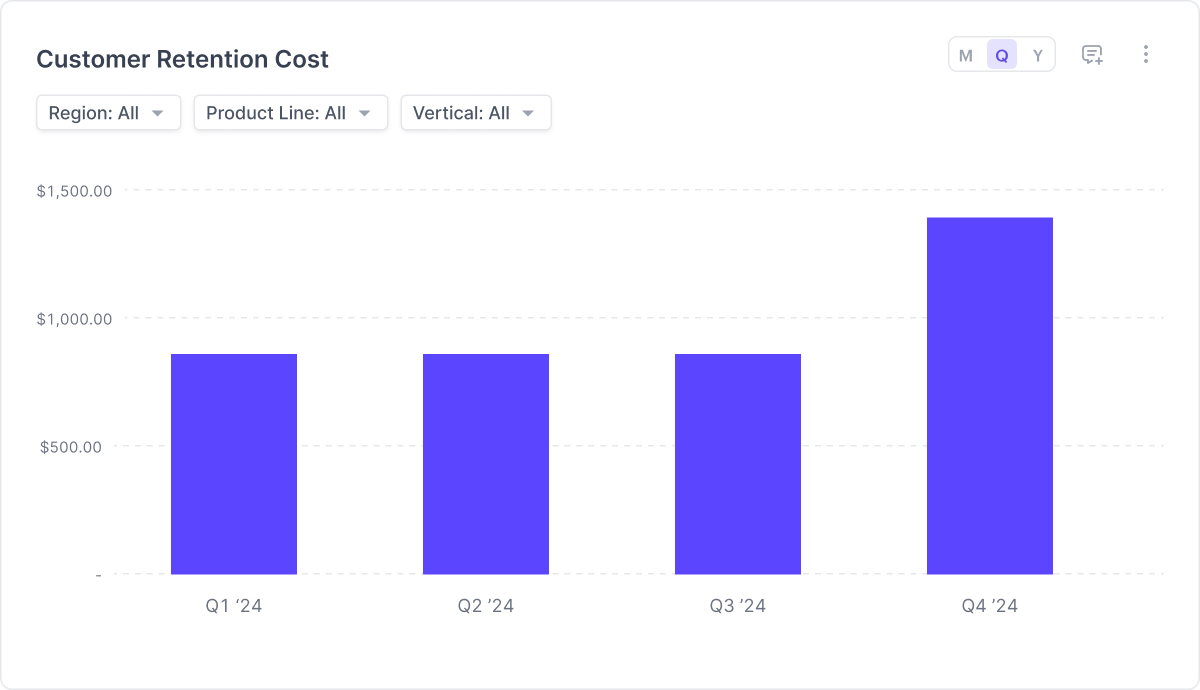




.png)
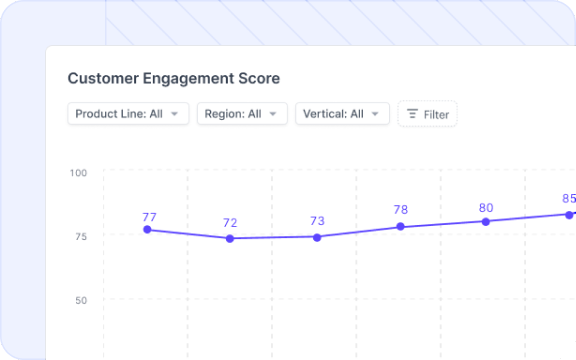



.svg)

